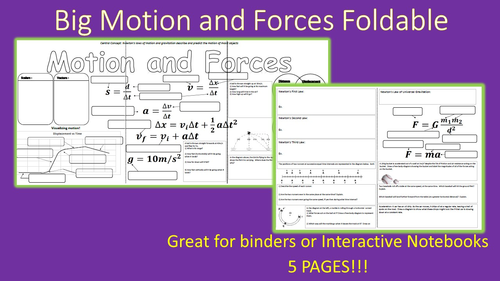






Motion and Forces review foldable for interactive notebooks or binders. Print double sided so it includes 5 pages of information (or print single sided to hang on the wall)! There is also a mini-book version included for a different approach to the material.
Reviews Scalars, Vectors, Distance, Displacement, Speed, Velocity, Acceleration, Force, Newton's Laws, Projectiles, and Gravity! Great for end of unit, midterm, final, or standardized test prep! No more boring study guides! Fully editable template for easy adjustment to fit your individual needs as well as PDF format. Full answer key included!
Teaching duration varies by use and student ability.
MA State Frameworks:
1. Motion and Forces
Central Concept: Newton’s laws of motion and gravitation describe and predict the motion of most objects.
1.1 Compare and contrast vector quantities (e.g., displacement, velocity, acceleration force, linear momentum) and scalar quantities (e.g., distance, speed, energy, mass, work).
1.2 Distinguish between displacement, distance, velocity, speed, and acceleration. Solve problems involving displacement, distance, velocity, speed, and constant acceleration.
1.3 Create and interpret graphs of 1-dimensional motion, such as position vs. time, distance vs. time, speed vs. time, velocity vs. time, and acceleration vs. time where acceleration is constant.
1.4 Interpret and apply Newton’s three laws of motion.
1.5 Use a free-body force diagram to show forces acting on a system consisting of a pair of interacting objects. For a diagram with only co-linear forces, determine the net force acting on a system and between the objects.
1.6 Distinguish qualitatively between static and kinetic friction, and describe their effects on the motion of objects.
1.7 Describe Newton’s law of universal gravitation in terms of the attraction between two objects, their masses, and the distance between them.
1.8 Describe conceptually the forces involved in circular motion.
Total Pages15Answer KeyIncluded
Reviews Scalars, Vectors, Distance, Displacement, Speed, Velocity, Acceleration, Force, Newton's Laws, Projectiles, and Gravity! Great for end of unit, midterm, final, or standardized test prep! No more boring study guides! Fully editable template for easy adjustment to fit your individual needs as well as PDF format. Full answer key included!
Teaching duration varies by use and student ability.
MA State Frameworks:
1. Motion and Forces
Central Concept: Newton’s laws of motion and gravitation describe and predict the motion of most objects.
1.1 Compare and contrast vector quantities (e.g., displacement, velocity, acceleration force, linear momentum) and scalar quantities (e.g., distance, speed, energy, mass, work).
1.2 Distinguish between displacement, distance, velocity, speed, and acceleration. Solve problems involving displacement, distance, velocity, speed, and constant acceleration.
1.3 Create and interpret graphs of 1-dimensional motion, such as position vs. time, distance vs. time, speed vs. time, velocity vs. time, and acceleration vs. time where acceleration is constant.
1.4 Interpret and apply Newton’s three laws of motion.
1.5 Use a free-body force diagram to show forces acting on a system consisting of a pair of interacting objects. For a diagram with only co-linear forces, determine the net force acting on a system and between the objects.
1.6 Distinguish qualitatively between static and kinetic friction, and describe their effects on the motion of objects.
1.7 Describe Newton’s law of universal gravitation in terms of the attraction between two objects, their masses, and the distance between them.
1.8 Describe conceptually the forces involved in circular motion.
Total Pages15Answer KeyIncluded
Something went wrong, please try again later.
This resource hasn't been reviewed yet
To ensure quality for our reviews, only customers who have purchased this resource can review it
Report this resourceto let us know if it violates our terms and conditions.
Our customer service team will review your report and will be in touch.
$5.99
